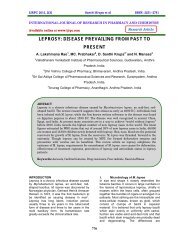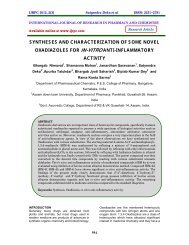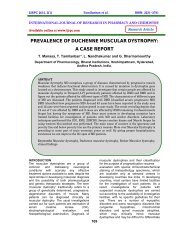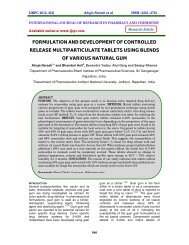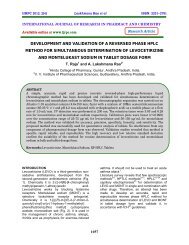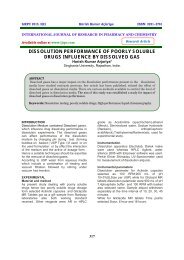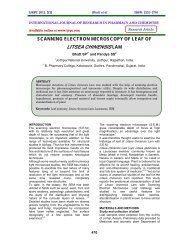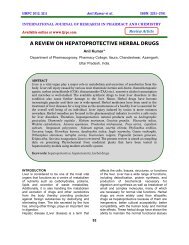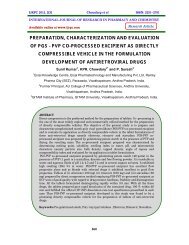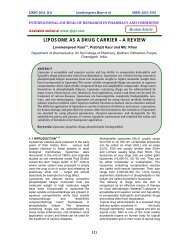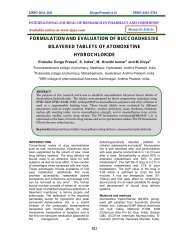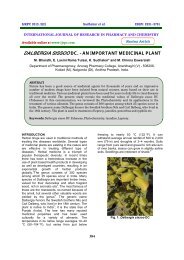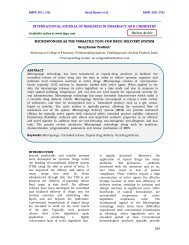evaluation of anti-diabetic activity of leaves of cassia ... - ijrpc
evaluation of anti-diabetic activity of leaves of cassia ... - ijrpc
evaluation of anti-diabetic activity of leaves of cassia ... - ijrpc
You also want an ePaper? Increase the reach of your titles
YUMPU automatically turns print PDFs into web optimized ePapers that Google loves.
IJRPC 2011, 1(4) Prabh Simran Singh et al. ISSN: 22312781<br />
INTERNATIONAL JOURNAL OF RESEARCH IN PHARMACY AND CHEMISTRY<br />
Available online at www.<strong>ijrpc</strong>.com<br />
Research Article<br />
EVALUATION OF ANTI-DIABETIC ACTIVITY OF<br />
LEAVES OF CASSIA OCCIDENTALIS<br />
Prabh Simran Singh 1 *, Chetan Salwan 2 and A.S. Mann 3<br />
1 SBS College <strong>of</strong> Pharmacy, Patti, Tarn-Taran Punjab, India.<br />
2 S. Sukhjinder Singh College <strong>of</strong> Pharmacy, Gurdaspur, Punjab.<br />
3B.I.S College <strong>of</strong> Pharmacy, Moga, Punjab, India.<br />
*Corresponding Author: prabh.7750@gmail.com<br />
ABSTRACT<br />
Many plants synthesize substances that are useful to the maintenance <strong>of</strong> health in humans<br />
and other animals. These include aromatic substances, most <strong>of</strong> which are phenols or their<br />
oxygen-substituted derivatives such as tannins. Many are secondary metabolites, <strong>of</strong> which<br />
at least 12,000 have been isolated — a number estimated to be less than 10% <strong>of</strong> the total. In<br />
many cases, substances such as alkaloids serve as plant defense mechanisms against<br />
predation. Diabetes mellitus <strong>of</strong>ten simply referred to as diabetes—is a condition in which a<br />
person has a high blood sugar (glucose) level as a result <strong>of</strong> the body either not producing<br />
enough insulin, or because body cells do not properly respond to the insulin that is<br />
produced. Insulin is a hormone produced in the pancreas which enables body cells to<br />
absorb glucose, to turn into energy. Cassia occidentalis is an annual shrub. The <strong>leaves</strong>, roots<br />
& entire plant as such has been used in various countries like China, Brazil, Sri Lanka &<br />
India in the treatment <strong>of</strong> the variety <strong>of</strong> ailments such as malaria, liver diseases, fungal<br />
infections etc.Thorough literature survey for the chemical nature <strong>of</strong> the plant reveals that<br />
the plant contains quinines, flavonoids, saponins and alkaloids. The ethnomedical<br />
information reveals the plant has been used to treat diabetes.<br />
Keywords: Insulin, Diabetes, Hyperglycemia, Pancreas, Hormone.<br />
INTRODUCTION<br />
Many <strong>of</strong> the herbs and spices used by humans<br />
to season food yield useful medicinal<br />
compounds (Lai & Roy, 2004). The use <strong>of</strong><br />
herbal medicines in the right way provides<br />
effective and safe treatment for many<br />
ailments. The effectiveness <strong>of</strong> the herbal<br />
medicines is mostly subjective to the patient.<br />
The potency <strong>of</strong> the herbal medicines varies<br />
based on the genetic variation <strong>of</strong> the herbs,<br />
growing conditions <strong>of</strong> the herbs, timing and<br />
method <strong>of</strong> harvesting <strong>of</strong> the herbs, exposure <strong>of</strong><br />
the herbs to air, light and moisture, and type<br />
<strong>of</strong> preservation <strong>of</strong> the herbs. Herbal medicines<br />
can be used for healing purposes and to<br />
promote wellness. Herbal medicines are not<br />
addictive or habit forming, but are powerful<br />
nutritional agents that support the body<br />
naturally. Herbal medicines promote health<br />
and serve as excellent healing agents without<br />
side effects. Chinese herbs are taken as tonics<br />
to enhance physical and mental well-being.<br />
Herbal medicines are safe and effective for<br />
health, healing, weight loss/ gain/<br />
maintenance, etc. Herbal medicine can nourish<br />
the body’s deepest and most basic elements.<br />
Herbal medicines are great body balancers<br />
that help regulate body functions. Natural<br />
therapies such as herbal medicines can be used<br />
to support balance process <strong>of</strong> our body.<br />
Herbal medicines <strong>of</strong>fer the nutrients that the<br />
904
IJRPC 2011, 1(4) Prabh Simran Singh et al. ISSN: 22312781<br />
body fails to receive due to poor diet or<br />
environmental deficiencies in the soil and air.<br />
If the body cells do not absorb the glucose, the<br />
glucose accumulates in the blood<br />
(hyperglycemia), leading to various potential<br />
medical complications (Rother, 2007).<br />
There are many types <strong>of</strong> diabetes, the most<br />
common <strong>of</strong> which are<br />
Type 1 diabetes<br />
Results from the body's failure to produce<br />
insulin, and presently requires the person to<br />
inject insulin.<br />
Type 2 diabetes<br />
Results from insulin resistance, a condition in<br />
which cells fail to use insulin properly,<br />
sometimes combined with an absolute insulin<br />
deficiency.<br />
Gestational diabetes is when pregnant<br />
women, who have never had diabetes before,<br />
have a high blood glucose level during<br />
pregnancy. It may precede development <strong>of</strong><br />
type 2 DM. As <strong>of</strong> 2009 at least 271 million<br />
people worldwide suffer from diabetes, or<br />
2.8% <strong>of</strong> the population.Type 2 diabetes is by<br />
far the most common, affecting 80 to 85% <strong>of</strong><br />
the total diabetes population.<br />
Classification<br />
Most cases <strong>of</strong> diabetes mellitus fall into the<br />
three broad categories<br />
<strong>of</strong> type 1 or type 2 and gestational diabetes. A<br />
few other types are described:<br />
The term diabetes, without qualification,<br />
usually refers to diabetes mellitus, which<br />
roughly translates to excessive sweet urine<br />
(known as "glycosuria"). Several rare<br />
conditions are also named diabetes. The most<br />
common <strong>of</strong> these is diabetes insipidus in<br />
which large amounts <strong>of</strong> urine are produced<br />
(polyuria), which is not sweet (insipidus<br />
meaning "without taste" in Latin). The term<br />
"type 1 diabetes" has replaced several former<br />
terms, including childhood-onset diabetes,<br />
juvenile diabetes, and insulin-dependent<br />
diabetes mellitus (IDDM). Likewise, the term<br />
"type 2 diabetes" has replaced several former<br />
terms, including adult-onset diabetes, obesityrelated<br />
diabetes, and non-insulin-dependent<br />
diabetes mellitus (NIDDM). Beyond these two<br />
types, there is no agreed-upon standard<br />
nomenclature. Various sources have defined<br />
"type 3 diabetes" as: gestational<br />
diabetes, insulin-resistant type 1 diabetes (or<br />
"double diabetes"), type 2 diabetes which has<br />
progressed to require injected insulin,<br />
and latent autoimmune diabetes <strong>of</strong> adults (or<br />
LADA or "type 1.5" diabetes).<br />
Overview <strong>of</strong> the most significant symptoms<br />
<strong>of</strong> diabetes<br />
The classical symptoms <strong>of</strong> DM arepolyuria<br />
(frequent urination), polydipsia (increased<br />
thirst) andpolyphagia (increased hunger)<br />
(Cooke &Plotnick,2008). Symptomsmay<br />
develop quite rapidly (weeks or months) in<br />
type 1 diabetes, particularly in children.<br />
However, in type 2 diabetes symptoms<br />
usually develop much more slowly and may<br />
be subtle or completely absent. Type 1<br />
diabetes may also cause a rapid yet significant<br />
weight loss (despite normal or even increased<br />
eating) and irreducible mental fatigue. All <strong>of</strong><br />
these symptoms except weight loss can also<br />
manifest in type 2 diabetes in patients whose<br />
diabetes is poorly controlled, although<br />
unexplained weight loss may be experienced<br />
at the onset <strong>of</strong> the disease. Final diagnosis is<br />
made by measuring the blood glucose<br />
concentration. When the glucose concentration<br />
in the blood is raised beyond its renal<br />
threshold (about 10 mmol/L, although this<br />
may be altered in certain conditions, such as<br />
pregnancy), reabsorption <strong>of</strong> glucose in<br />
the proximal renal tubuli is incomplete, and<br />
part <strong>of</strong> the glucose remains in<br />
the urine (glycosuria). This increases<br />
the osmotic pressure <strong>of</strong> the urine and inhibits<br />
reabsorption <strong>of</strong> water by the kidney, resulting<br />
in increased urine production (polyuria) and<br />
increased fluid loss. Lost blood volume will be<br />
replaced osmotically from water held in body<br />
cells and other body compartments, causing<br />
dehydration and increased thirst. A rarer but<br />
equally severe possibility is hyperosmolar<br />
nonketotic state, which is more common in<br />
type 2 diabetes and is mainly the result <strong>of</strong><br />
dehydration due to loss <strong>of</strong> body water. Often,<br />
the patient has been drinking extreme<br />
amounts <strong>of</strong> sugar-containing drinks, leading<br />
to a vicious circle in regard to the water loss. A<br />
number <strong>of</strong> skin rashes can occur in diabetes<br />
that is collectively known as <strong>diabetic</strong><br />
dermadromes.<br />
Causes<br />
Type 2 diabetes is determined primarily by<br />
lifestyle factors and genes (Riseruset al,2009).<br />
905
IJRPC 2011, 1(4) Prabh Simran Singh et al. ISSN: 22312781<br />
Lifestyle<br />
A number <strong>of</strong> lifestyle factors are known to be<br />
important to the development <strong>of</strong> type 2<br />
diabetes. In one study, those who had high<br />
levels <strong>of</strong> physical <strong>activity</strong>, a healthy diet, did<br />
not smoke, and consumed alcohol in<br />
moderation had an 82% lower rate <strong>of</strong> diabetes.<br />
When a normal weight was included the rate<br />
was 89% lower. In this study a healthy diet<br />
was defined as one high in fiber, with a high<br />
polyunsaturated to saturated fat ratio, and a<br />
lower mean glycemic index (Mozaffarianet al,<br />
2009) Obesity has been found to contribute to<br />
approximately 55% type 2 diabetes, and<br />
decreasing consumption <strong>of</strong> saturated<br />
fats and trans fatty acids while replacing them<br />
with unsaturated fats may decrease the<br />
risk. The increased rate <strong>of</strong> childhood obesity in<br />
between the 1960s and 2000s is believed to<br />
have lead to the increase in type 2 diabetes in<br />
children and adolescents ( Roselbloom&<br />
Silverstein, 2003). Environmental toxins may<br />
contribute to recent increases in the rate <strong>of</strong><br />
type 2 diabetes. A positive correlation has<br />
been found between the concentration in the<br />
urine <strong>of</strong> bisphenol A, a constituent <strong>of</strong> some<br />
plastics, and the incidence <strong>of</strong> type 2 diabetes<br />
(Lang et al,2008).<br />
Medical conditions<br />
Subclinical Cushing's syndrome (cortisol<br />
excess) may be associated with DM type 2<br />
(Iwasaki et al, 2008). The percentage <strong>of</strong><br />
subclinical Cushing's syndrome in the <strong>diabetic</strong><br />
population is about 9%. Diabetic patients with<br />
a pituitary microadenoma can improve<br />
insulin sensitivity by removal <strong>of</strong> these<br />
microadenomas(Taniguchi et al,<br />
2008).Hypogonadismis <strong>of</strong>ten associated with<br />
cortisol excessandtestosteronedeficiencyis also<br />
associated with diabetes mellitus type<br />
2(Saad&Gooren, 2009) even if the exact<br />
mechanism by which testosterone improve<br />
insulin sensitivity is still not known.<br />
Pathophysiology<br />
The pathophysiology <strong>of</strong> type 2 diabetes<br />
mellitus is characterized by peripheral insulin<br />
resistance, impaired regulation <strong>of</strong><br />
hepatic glucose production, and declining ß-<br />
cell function, eventually leading to ß-cell<br />
failure. The primary events are believed to be<br />
an initial deficit in insulin secretion and, in<br />
many patients, relative insulin deficiency in<br />
association with peripheral insulin resistance<br />
(Reaven,1998).<br />
Herbal <strong>anti</strong>-<strong>diabetic</strong> drugs<br />
It has become increasingly evident in recent<br />
years that a full spectrum <strong>of</strong> therapeutic<br />
agents for prevention & treatment <strong>of</strong> diabetes<br />
is far from being complete.In an attempt to fill<br />
this gap,drug development focus has now<br />
shifted to traditional herbal drugs for new &<br />
more effective drug therapies.The search for<br />
indigenous <strong>anti</strong>-<strong>diabetic</strong> plants is still going<br />
on.Several plants have been identified as<br />
potential source <strong>of</strong> drugs in Indian system <strong>of</strong><br />
ayurvedic medicine for treatment <strong>of</strong><br />
diabetes.Extracts <strong>of</strong> various plants have been<br />
shown to posseshypoglycaemic properties in<br />
experimental <strong>diabetic</strong> as well as normal<br />
animals<br />
MATERIAL AND METHOD<br />
Introduction <strong>of</strong> Diabetes in Mice<br />
Diabetes was induced in animals by a single<br />
intraperitoneal injection <strong>of</strong> alloxan (40 mg/kg)<br />
dissolved in 0.1 M citrate buffer (pH 4.5) after<br />
fasting for 24 hour. Blood samples for glucose,<br />
cholesterol and other estimations were<br />
obtained retro-orbitally from the inner canthus<br />
<strong>of</strong> eyes using microcapillaries. Rats with<br />
fasting blood glucose <strong>of</strong> more than 220 mg/dl<br />
were considered to be <strong>diabetic</strong> and were<br />
included in the present study.<br />
ALLOXAN<br />
The cellular site <strong>of</strong> action <strong>of</strong> alloxan and exact<br />
mechanisms involved in its toxicity are not<br />
completely understood. Number <strong>of</strong> studies<br />
have shown that alloxan disrupts the integrity<br />
<strong>of</strong> the β-cell plasma membrane .The site at<br />
which alloxan interacts with the cell<br />
membrane is uncertain. Some evidence<br />
indicates that alloxan actsat the site for sugar<br />
transport into the cell. On the other hand,<br />
there is also evidence to suggest that alloxan<br />
acts at a glucoreceptor site responsible for<br />
insulin release, which is separate from the<br />
transport site .It has also been proposed those<br />
alloxan , leads to mitochondrial dysfunction<br />
and interferes with intracellular glucose<br />
oxidation . There is a large variability in<br />
dosage <strong>of</strong> alloxan required to produce longstanding<br />
diabetes in different species, which is<br />
also compatible with life. In many<br />
experiments, a single dose (32 to 200 mg/kg)<br />
was adequate to produce desired degree <strong>of</strong><br />
hyperglycemia, while in certain other studies<br />
906
IJRPC 2011, 1(4) Prabh Simran Singh et al. ISSN: 22312781<br />
it had to be repeated after 3 days. In the<br />
chronic state, hyperglycemia remains constant<br />
and blood glucose levels <strong>of</strong> 400 mg or more<br />
can be expected after standard diabetogenic<br />
doses <strong>of</strong> alloxan and streptozotocin (STZ) ,<br />
high dosages <strong>of</strong> the β-cell toxin streptozotocin<br />
and alloxan induce severe insulin deficiency<br />
and IDDM with ketosis. Lower dosages<br />
calculated to cause a partial reduction <strong>of</strong> β-cell<br />
mass could be used to produce a mildly<br />
insulin-deficient state <strong>of</strong> NIDDM, without a<br />
tendency to ketosis .The dosage is difficult to<br />
judge to create stable NIDDM without either<br />
gradual recovery or deterioration into IDDM.<br />
Streptozotocin is preferred because it has more<br />
specific cytotoxicity, to β-cell <strong>of</strong> the pancreas.<br />
Qu<strong>anti</strong>tative Estimation <strong>of</strong> Blood Glucose<br />
Blood glucose level was estimated<br />
colorimetrically at 505 nm by Glucose<br />
Oxidase-Peroxidase (GOD-POD) method<br />
(Trinder's method) using a commercially<br />
available kit (Transasia Bio Medicals Ltd.<br />
Daman).<br />
Principle<br />
Qu<strong>anti</strong>tative estimation <strong>of</strong> blood glucose level<br />
by GOD-POD method is based on the<br />
principle that enzyme glucose oxidase reacts<br />
with glucose in the presence <strong>of</strong> oxygen and<br />
water to form gluconic acid and hydrogen<br />
peroxide. This hydrogen peroxide reacts with<br />
4-amino <strong>anti</strong>pyrine and 4-hydroxybenzoic<br />
acid in the presence <strong>of</strong> the enzyme peroxidase<br />
to form quinoneimine dye and water. The<br />
pink coloured end product has absorption<br />
maxima at 505 nm. The intensity <strong>of</strong> the pink<br />
colour formed is proportional to the glucose<br />
concentration.<br />
Glucose +O 2 + H 2OGlucose oxidase Gluconic acid + H 2O 2<br />
H 2O 2 + 4HBA + 4AAPPeroxidaseQuinoneimine Dye + 2H 2O<br />
4AAP _______ 4-Amino<strong>anti</strong>pyrine<br />
4HBA _____ 4-Hydroxy benzoic acid.<br />
Serum separation<br />
Blood was withdrawn retro-orbitally with the<br />
help <strong>of</strong> microcapillaries. The collected blood<br />
was kept for 30 mins at room temperature.<br />
Serum from blood after clotting was separated<br />
out by centrifugation at 3000 rpm for 15<br />
minutes. The serum thus obtained was used<br />
for glucose and cholesterol estimations.<br />
Blank<br />
To 10 l <strong>of</strong> distilled water, 1000 l <strong>of</strong> glucose<br />
working reagent was added and the contents<br />
were thoroughly mixed.<br />
O.D. Test<br />
Concentration <strong>of</strong> glucose (mg/dl) = x 100<br />
O.D. Standard<br />
Standard<br />
To 10 µl <strong>of</strong> glucose standard (100 mg/dl), 1000<br />
l <strong>of</strong> glucose working reagent was added and<br />
the contents were thoroughly mixed.<br />
Test<br />
To 10 µl <strong>of</strong> serum, 1000 µl <strong>of</strong> glucose working<br />
reagent was added and were mixed<br />
thoroughly. The above solution was mixed<br />
well and incubated for 15 minutes at 37 0 C.<br />
The absorbance <strong>of</strong> standard and each test tube<br />
was read against blank at 505 nm.<br />
Qu<strong>anti</strong>tative Estimation <strong>of</strong> Serum Cholesterol<br />
Serum cholesterol was estimated at 505 nm by<br />
CHOD-PAP method (Modified Roeschlau's<br />
method) using a commercially available kit<br />
(Transasia Bio Medicals Ltd. Daman).<br />
Principle<br />
Qu<strong>anti</strong>tative estimation <strong>of</strong> serum cholesterol<br />
level by CHOD-PAP method is based upon<br />
the principle that enzyme cholesterol esterase<br />
reacts with cholesterol ester to form<br />
cholesterol and fatty acid. The cholesterol<br />
formed reacts with enzyme cholesterol oxidase<br />
in the presence <strong>of</strong> oxygen give rise to cholest-<br />
4-en-3-one and hydrogen peroxide. This<br />
hydrogen peroxide reacts with 4-<br />
amino<strong>anti</strong>pyrine and phenol in the presence <strong>of</strong><br />
quinoneimine dye and water. The pink<br />
colored end product has absorbance maxima<br />
at 505 nm. The intensity <strong>of</strong> pink color formed<br />
is proportional to the cholesterol<br />
concentration. 907
IJRPC 2011, 1(4) Prabh Simran Singh et al. ISSN: 22312781<br />
Cholesterol ester CE Gluconic acid + H2O2<br />
Cholesterol+O2 CHOD cholest-4-en-3-one + H2O2<br />
3H2O2 + 4AAP + Phenol POD Quinoneimine Dye + 2H2O<br />
CE_______Cholesterol esterase<br />
CHOD_______Cholesterol oxidase<br />
4AAP _______ 4-Amino<strong>anti</strong>pyrine<br />
POD _____ Peroxidase<br />
Blank<br />
To 20 l <strong>of</strong> distilled water, 1000 l <strong>of</strong><br />
cholesterol working reagent was added and<br />
the contents were thoroughly mixed.<br />
Standard<br />
To 20 µl <strong>of</strong> cholesterol standard (5.14mmol/l),<br />
1000 l <strong>of</strong> cholesterol working reagent was<br />
added and the contents were thoroughly<br />
mixed.<br />
Test<br />
To 20 µl <strong>of</strong> serum, 1000 µl <strong>of</strong> cholesterol<br />
working reagent was added and were mixed<br />
thoroughly. The above solution was mixed<br />
well and incubated for 15 minutes at 37 0 C.<br />
The absorbance <strong>of</strong> standard and each test tube<br />
was read against blank at 505 nm.<br />
Concentration <strong>of</strong> cholesterol (mmol/l) =<br />
O.D. Test<br />
O.D. Standard<br />
x 5.14mmol/l<br />
Serum Lipids<br />
Total cholesterol, LDL- and HDL- cholesterol<br />
and triacylglycerol were estimated using kits<br />
from Dr. Reddy's Pathology Lab-Hyderabad<br />
following manufacturer's instructions.<br />
HDL-CHOLESTEROL<br />
Principle: Low-density lipoproteins (LDL and<br />
VLDL) and chylomicron fraction was<br />
precipitated qu<strong>anti</strong>tatively by addition <strong>of</strong><br />
phosphotungstic acid in the presence <strong>of</strong><br />
magnesium ions. After centrifugation. The<br />
cholesterol concentration in HDL fraction,<br />
which remains in the supernatant, is<br />
estimated.<br />
LDL- Cholesterol<br />
After estimating total cholesterol, HDL<br />
cholesterol and triacylglycerol,<br />
Triacylglycerols The LDL cholesterol<br />
(mg/100ml)=Total Cholesterol+ HDL<br />
(Cholesterol ) /5(Friedelwald 1972).<br />
Estimation <strong>of</strong> the concentration <strong>of</strong> low –<br />
density lipoprotein cholesterol in plasma,<br />
without use <strong>of</strong> the preparative ultracentrifuge.<br />
Determination <strong>of</strong> Body Weight<br />
The body weight <strong>of</strong> the experimental animals<br />
was determined using a commercially<br />
available weighing balance, prior to alloxan<br />
treatment and after the administration <strong>of</strong><br />
alloxan.<br />
Experimental Protocol<br />
Four groups were included in the present<br />
study and each group comprised <strong>of</strong> six<br />
animals.<br />
Group 1: Normal control<br />
Group 2: Diabetic control (alloxan treated)<br />
Group 3: Diabetic mice treated with butanolic<br />
extract<br />
( 20 mg/kg/once a day, orally)<br />
Group4 : Diabetic mice treated with aqueous<br />
extract<br />
( 30 mg/kg/once a day, orally)<br />
Statistical Analysis<br />
The data for blood glucose, cholesterol, body<br />
weight and were expressed as mean ± S.E.M.<br />
Data was analysed using one-way ANOVA.<br />
Multiple range Tukey’s test was employed as<br />
post-hoc test for comparison between various<br />
groups and with control group. p ≤ 0.05 was<br />
considered to be statistically significant.<br />
908
IJRPC 2011, 1(4) Prabh Simran Singh et al. ISSN: 22312781<br />
RESULTS AND DISCUSSION<br />
Effect <strong>of</strong> Cassia occidentalis extracts on the<br />
plasma glucose values <strong>of</strong> various groups<br />
Plasma glucose levels <strong>of</strong> all the experimental<br />
animals were examined at the end <strong>of</strong> the<br />
study. The <strong>diabetic</strong> control group showed<br />
significant increase (300.7± 10.88) as compared<br />
to normal control group (84±9.30). DTB group<br />
showed significant reduction in plasma<br />
glucose levels (95.2± 7.46). DTA group (119.6±<br />
29.03) showed significant reduction but was<br />
less as compared with the DTB group (Fig. 1)<br />
Table 1.<br />
Effect <strong>of</strong> Cassia occidentalis extracts on the<br />
Total cholesterol values <strong>of</strong> various groups<br />
Total cholesterol levels <strong>of</strong> all the experimental<br />
animals were examined at the end <strong>of</strong> the<br />
study. The <strong>diabetic</strong> control group showed<br />
significant increase (246 ± 14.4 ) as compared<br />
to normal control group (168.6 ± 16.9). DTB<br />
group showed significant reduction in plasma<br />
glucose levels (186± 14.8). DTA group (190±<br />
14.81) significant reduction which was slightly<br />
less as compared with the DTB group (Fig. 2).<br />
Effect <strong>of</strong> Cassia occidentalis extracts on the<br />
HDL values <strong>of</strong> various groups<br />
The HDL levels remained largely unchanged<br />
in all the groups throughout the study (Fig. 3).<br />
Effect <strong>of</strong> Cassia occidentalis extracts on the<br />
LDL values <strong>of</strong> various groups<br />
LDL values <strong>of</strong> all the groups were examined at<br />
the end <strong>of</strong> the study.The <strong>diabetic</strong> control<br />
group showed significant increase (152.2±6.0)<br />
as compared to normal control<br />
group(78±6.2).DTB group showed significant<br />
reduction in LDL levels(99.7±7.3).Reduction in<br />
LDL levels in DTA group (111±5.1) was also<br />
significant as compared to DTB group.(Fig. 4)<br />
Effect <strong>of</strong> Cassia occidentalis extracts on the<br />
TAG values <strong>of</strong> various groups<br />
TAG levels <strong>of</strong> <strong>diabetic</strong> control group<br />
(181.8±18.8) showed significant increase as<br />
compared to the normal control group.TAG<br />
values <strong>of</strong> DTB and DTA remained largely<br />
unchanged. (Fig. 5) Table 2.<br />
Effect <strong>of</strong> Cassia occidentalis extracts on the<br />
body weights <strong>of</strong> various groups<br />
Body weight <strong>of</strong> the <strong>diabetic</strong> control group was<br />
reduced significantly as compared to the<br />
normal group while body weights <strong>of</strong> the DTA<br />
and DTB groups remained largely unchanged.<br />
(Fig. 6) Table 3.<br />
CONCLUSION<br />
The transverse section <strong>of</strong> stem showed greatly<br />
thickened and heavily cutinized outer walls <strong>of</strong><br />
the epidermis, rectangular cells <strong>of</strong> the<br />
epidermis, pericycle and vascular bundles.<br />
The leaf constants such as vein islet number,<br />
vein termination number,stomatal<br />
index,stomatal number were determined and<br />
recorded.<br />
Extractive values such as butanolic extractives<br />
and water soluble extractives were determined<br />
and recorded.<br />
The butanolic extracts and the aqueous<br />
extracts brought down the plasma glucose<br />
values to normal values with the butanolic<br />
extracts having more pr<strong>of</strong>ound effect. So we<br />
can expect that the Cassia occidentalis extracts<br />
either repaired the damaged pancreas or the<br />
extract stimulated directly the utilization <strong>of</strong><br />
glucose by various tissues.<br />
Hence, it was concluded that the leaf extracts<br />
have <strong>anti</strong>-<strong>diabetic</strong> <strong>activity</strong>. The various<br />
photochemical present in the extracts may be<br />
isolated to study which <strong>of</strong> them is responsible<br />
for <strong>anti</strong>-<strong>diabetic</strong> <strong>activity</strong>.<br />
Table 1: Effect <strong>of</strong> Butanolic and Aqueous Extracts on<br />
the Plasma Glucose Levels<br />
Group<br />
Plasma glucose levels<br />
(after 4 weeks)<br />
Normal(control) 84.0±9.30<br />
Diabetic control<br />
300.7±10.88 a<br />
Diabetic treated (butanolic) 95.2±7.46 b<br />
Diabetic treated (aqueous) 119.6±13.03 b<br />
Data are expressed in Mean± SEM(n=6)<br />
a = p< 0.05 vs normal control group<br />
b = p
IJRPC 2011, 1(4) Prabh Simran Singh et al. ISSN: 22312781<br />
Table 2: Effect <strong>of</strong> Butanolic and Aqueous Extracts<br />
on the Serum Lipid Pr<strong>of</strong>ile<br />
Group<br />
Total<br />
cholesterol<br />
(mg/dl)<br />
LDL<br />
(mg/dl)<br />
HDL<br />
(mg/dl)<br />
TAG (mg/dl)<br />
Normal(control) 168.6±16.9 78.0±12.2 44.9±13.3 115.6±18.6<br />
Diabetic control 246.0±14.4 a 152.2±12.6 a 45.0±12.0 181.8±18.8 a<br />
Diabetic treated 186.0±14.8 b 99.7±16.8 b 51.3±8.4 175.0±15.8<br />
(butanolic )<br />
Diabetic treated 190±14.81 b 111±12.8 b 47.2±6.87 187.6±15.17<br />
(aqueous)<br />
Data are expressed in Mean± SEM(n=6)<br />
a=p
IJRPC 2011, 1(4) Prabh Simran Singh et al. ISSN: 22312781<br />
DC- Diabetic control<br />
DTB- Diabetic treated with butanolic extracts<br />
200<br />
100<br />
Low Density Lipoproteins Values After 4<br />
Weeks<br />
a<br />
b<br />
b<br />
0<br />
Normal DC DTB DTA<br />
L)Groups<br />
Fig. 3: Effect <strong>of</strong> Cassia Occidentalis extracts on the<br />
Low density Lipoprotein Values <strong>of</strong> Various Groups<br />
DC- Diabetic control<br />
DTB- Diabetic treated with butanolic extracts<br />
DTA- Diabetic treated with aqueous extract.<br />
High density Lipoprotein Values After 4 Weeks<br />
60<br />
50<br />
40<br />
30<br />
20<br />
10<br />
0<br />
Normal DC DTB DTA HGroups<br />
Fig. 4: Effect <strong>of</strong> Cassia Occidentalis extracts on the High<br />
density Lipoprotein Values <strong>of</strong> Various Groups<br />
DC- Diabetic control<br />
DTB- Diabetic treated with butanolic extracts<br />
300<br />
200<br />
100<br />
0<br />
Triacylglycerol Values After 4 Weeks<br />
a<br />
Normal DC DTB DTA<br />
TGroups<br />
Fig. 5: Effect <strong>of</strong> Cassia Occidentalis Extracts on the<br />
Triacylglycerol Values <strong>of</strong> Various Groups 911<br />
DC- Diabetic control
IJRPC 2011, 1(4) Prabh Simran Singh et al. ISSN: 22312781<br />
DTB- Diabetic treated with butanolic extracts<br />
DTA- Diabetic treated with aqueous extract<br />
250<br />
200<br />
150<br />
100<br />
50<br />
0<br />
Body Weight After 4 Weeks<br />
a<br />
Normal DC DTB DTA<br />
BGroups<br />
Fig. 6: Effect <strong>of</strong> Cassia occidentalis Extracts on the<br />
Body Weights <strong>of</strong> Various Groups<br />
DC- Diabetic control<br />
DTB- Diabetic treated with butanolic extracts<br />
DTA- Diabetic treated with aqueous extracts<br />
REFERENCES<br />
1. Abo KA, Lasaki SW and Adeyemi AA.<br />
Laxative and Antimicrobial Properties<br />
<strong>of</strong> Cassia Species Growing in Ibadan.<br />
Nigerian J <strong>of</strong> Natural Products & Med.<br />
1999;3:47-53.<br />
2. Lai PK and Roy J. Antimicrobial and<br />
chemopreventive properties <strong>of</strong> herbs<br />
and spices. Current Medicinal Chem.<br />
2004;11:1451–60.<br />
3. Rother KI. Diabetes treatmentbridging<br />
the divide. The New England<br />
j <strong>of</strong> Medicine. 2007;356: 1499–501.<br />
4. Cooke DW and Plotnick L. Type 1<br />
diabetes mellitus in pediatrics.<br />
Pediatrics Review. 2008;29: 374–84.<br />
5. Risérus U, Willett WC and Hu FB.<br />
Dietary fats and prevention <strong>of</strong> type 2<br />
diabetes. Progress in Lipid Research.<br />
2009;48:44–51.<br />
6. Mozaffarian D, Kamineni A,<br />
Carnethon M, Djoussé L, Mukamal KJ<br />
and Siscovic D. Lifestyle risk factors<br />
and new-onset diabetes mellitus in<br />
older adults: the cardiovascular health<br />
study. Archives <strong>of</strong> Internal Medicine.<br />
2009;169(8):798–807.<br />
7. Rosenbloom Arlan and Janet H<br />
Silverstein. Type 2 Diabetes in<br />
Children and Adolescents: A<br />
Clinician's Guide to Diagnosis,<br />
Epidemiology, Pathogenesis,<br />
Prevention, and Treatment. American<br />
Diabetes Association. 2003;10.<br />
8. Lang IA, Galloway TS and Scarlett A.<br />
Association <strong>of</strong> urinary bisphenol A<br />
concentration with medical disorders<br />
and laboratory abnormalities in<br />
adults. J <strong>of</strong> American Association.<br />
2008;300:1303–10.<br />
9. Iwasaki Y, Takayasu S and Nishiyama<br />
M. Is the metabolic syndrome an<br />
intracellular Cushing state? Effects <strong>of</strong><br />
multiple humoral factors on the<br />
transcriptional <strong>activity</strong> <strong>of</strong> the hepatic<br />
glucocorticoid-activating enzyme<br />
(11beta-hydroxysteroid<br />
dehydrogenase type 1) gene.<br />
Molecular and Cellular<br />
Endocrinology. 2008;285:10–18.<br />
10. Taniguchi T, Hamasaki A and<br />
Okamoto M. Endocrine Journal.<br />
2008;55:429–32.<br />
11. Teske M and Trentini, AMM.<br />
Compendium <strong>of</strong> herbal medicine.<br />
Curitiba. Botanical Laboratory.<br />
1994;32:268.<br />
12. Saad F and Gooren L. The role <strong>of</strong><br />
testosterone in the metabolic<br />
syndrome: a review. The Journal <strong>of</strong><br />
Steroid Biochemistry and Molecular<br />
Biology. 2009;114(1-2):40–3.<br />
13. Reaven GM. The role <strong>of</strong> insulin<br />
resistance in human disease, Diabetes,<br />
1998:37: 1595–1607. 912
IJRPC 2011, 1(4) Prabh Simran Singh et al. ISSN: 22312781<br />
14. World Health Organisation,<br />
Department <strong>of</strong> Noncommunicable<br />
Disease Surveillance, Definition,<br />
Diagnosis and Classification <strong>of</strong><br />
Diabetes Mellitus and its<br />
Complications. 1999.<br />
15. Yalow RS and Berson SA.<br />
Immunoassay <strong>of</strong> endogenous plasma<br />
insulin in man. Journal <strong>of</strong> Clinical<br />
Investigation. 1960;39:1157–1162.<br />
16. Yen GC, Chen HW and Duh PD.<br />
Extraction and identification <strong>of</strong> an<br />
<strong>anti</strong>oxidative component from jue<br />
ming zi Cassia tora L. J <strong>of</strong> Agriculture<br />
and Food Chem, 1998;46:820-4.<br />
913



